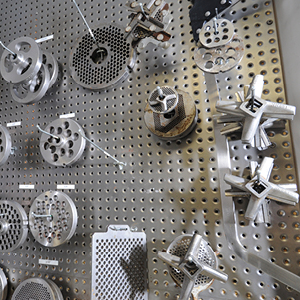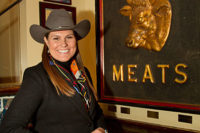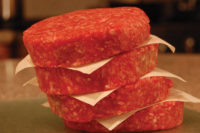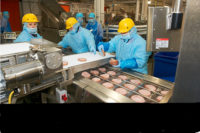
|
Although an untrained eye might assume that grinding and stuffing are simple, unscientific, straightforward processes, those in and around the meat industry know that there’s much more than goes into the making of ground meat and sausages, particularly in the grinding and stuffing phases.
Whether a company is producing bratwurst, Italian sausage, liver sausage or hard salami, there are many factors that can change the stuffing process considerably, in order to create the proper bite, texture, taste and sliceability (if required) in the product.
In The National Provisioner’s Sausage Technology Journal (full text available on our Web site, www.provisioneronline.com), Wesley N. Osburn, Ph.D., associate professor in the Department of Animal Science at Texas A&M University, walks readers through the different methods of stuffing, the types of equipment used and the reported results processors can expect from them.
Common sausage stuffers, Osburn says, include piston, auger or screw and rotary vane stuffers. Rotary vane stuffers are ideal for smaller applications that experience frequent product changeovers, because they minimize product loss. They also minimize product friction, Osburn adds. Augers come in a variety of configurations to handle evacuation of a variety of meat grinds, including emulsions, coarse grinds and restructured meats.
The process of grinding meat requires sharp focus on the calibrations of the grinding system in order to produce the texture and visual appeal desired in the final product. Commercial grinders, Osburn says, can handle meat that is fresh or frozen (minus-5°C to minus-10°C), and that many systems can grind 3,000 to 25,000 kilograms per hour, depending on the raw material and number of revolutions of the grinder system.
For grinding, however, it is essential to control the in-feed raw material and know its properties in order to get the desired outcome.
Furthermore, upkeep of the grinding system is important, especially along the lines of keeping knives and plates sharp and properly tightened within the assemble, Osburn states in the Technology Journal. Otherwise, a processor could experience product grease-out or poor particle definition in the final product.
Another factor affecting final product quality is the successful removal of bone chips and gristle, particularly in coarse-ground and emulsified sausage. Osburn says that various bone collection systems exist for grinders, each using either a center or peripheral discharge system to do its job.
Grinding and stuffing is only part of the overall process involved in sausage and ground meat production. Yet, although they seem to be the most straightforward processes in the chain of production, improper focus on the details of these processes can cause unwanted properties in the final product that is produced. Close attention should be paid to these steps in the process — as close attention as a processor would delegate to the formulation, mixing, cooking/chilling and packaging steps.
To read more about the sausage production process, as explained by Dr. Osburn and other technical experts, sign up at www.provisioneronline.com to read our Sausage Tech Journal.





Report Abusive Comment